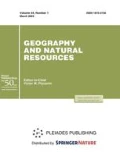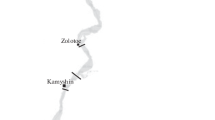Abstract
Long-term data from Rosgidromet and research results were used in comparing the chemistry condition of the southern reservoirs (Tsimlyansk, Proletarsk and Veselyi) to reveal that the ecologo-toxicological indices and characteristics of such intra-waterbody processes as pollution, eutrophication and toxification differ substantially. In the first place, the differences apply for the hydrochemical regime and mineralization as well as for individual biological indices. Common to the reservoirs are a stable (chronic) character of chemical contamination (in spite of its relatively low level), and a long-lasting presence of stable organochlorine pesticides in the composition of contamination, and a decline in biodiversity. The Tsimlyansk and Veselyi reservoirs show a similar seasonal dynamics of the phytoplankton, and a predominance of blue-green algae in the phytoplankton community. An unfavorable factor for the ecosystem of the Tsimlyansk reservoir is represented by annually recurring water bloom, with a large-scale occurrence of toxic species of algae, and by an increase in toxicity of natural water (toxification).
Similar content being viewed by others
References
Zhukova, S.V., Assessing the Influence on Water Bioresources and Their Habitat From the Operation of the Tsimlyansk and Manych Reservoirs, in Proc. of a Meeting of the Thematic Community for the Problems of Large Dams and of the Scientific Advising Council of the Interagency Ichthyological Commission “Fishery problems of the Construction and Operation of Large Dams and Ways to Solve Them”(February 25, 2010, Moscow), Compiled by A.S. Martynov and A.Yu. Knizhnikov, Moscow: WWF in Russia, 2010, pp. 47–66 [in Russian].
The Tsimlyansk Reservoir: The State of Water and Riparian Ecosystems, Problems and Ways to Solve Them, G.G. Matishev, Ed., Rostov-on-Don: Izd-vo YuNTs RAN, 2011 [in Russian].
Nikanorov, A.M., Khoruzhaya, T.A. and Martysheva, N.A., Present-Day Characteristics and Trends of Long-Term Changes in Ecological and Toxicological Conditions of the Tsimlyansk Reservoir, Russian Meteorology and Hydrology, 2012, vol. 37, no. 4, pp. 264–275.
Rumyantsev, V.A., Kryukov, L.N., Pozdnyakov, Sh.R., and Zhukovskii, A.V., Cyanobacterial Water “Bloom”: The Source of Nature Management Problems and an Impetus to Innovations in Russia, Obshchestvo. Sreda. Razvitie (Terra Humana), 2011, no. 2, pp. 222–228 [in Russian].
Khoruzhaya, T.A. and Nikanorov, A.V., Eutrophication and Toxicity of Blue-Green Algae as the Manifestation of Global Ecological Problems, Proc. All-Russian Sci. Conf. “Water and Water Resources: System-Forming Functions in Nature and the Economy” (July 23–29, 2012, Tsimlyansk), 2012, pp. 340–344 [in Russian].
Martysheva, N.A., Khoruzhaya, T.A. and Flik, E.A., Tendencies of Long-term Changes in Concentrations of Biogenic Elements in the Tsimlyansk Reservoir, Int. Sci. Conf. Dedicated to the 100th Anniversary of the Birth of G.V. Nikol’skii “Present State of Water Bioresources and Ecosystems of Sea and Fresh Waters: Problems and Mitigation Methods (September 20–23, 2012, Rostov-on-Don), 2010, pp. 220–223 [in Russian].
Khoruzhaya, T.A. and Martysheva, N.A., The Possible Influence of Phytocenoses in the Tsimlyansk Reservoir Upon Water Toxicity, Proc. IV All-Russian Conf. on Water Ecotoxicology in Commemoration of B.A. Flerov “Anthropogenic Influence Upon Water Organisms and Ecosystems (September 24–29, 2011, Borok), 2011, part 2, pp. 98–100 [in Russian].
Nikanorov, A.M., Khoruzhaya, T.A., Minina, L.I., and Martysheva, N.A., The “Bloom” Hazard of the Tsimlyansk Reservoir, Vodoochistka. Vodopodgotovka. Vodosnabzhenie, 2011, no. 2, pp. 70–74 [in Russian].
Nikanorov, A.M., Ivanik, V.M. and Pirumova, E.I., Long-Term Changes in Salt Composition of the Don Water in the Lower Reach: Causes and Tendencies, in The Water Ecosystem of the Lower Don: Long-Term Changes in Water Quality, A.M. Nikanorov, T.A. Khoruzhaya, L.I. Minina, et al., Eds., St. Petersburg: Gidrometeoizdat, 2006, pp. 247–256 [in Russian].
GOST 17.1.1.02-77. Nature Conservation. Hydrosphere. Classification of Water Bodies, Introduced 1978-07-01, Moscow: State Committee of the USSR for Standards, 1980 [in Russian].
The Quality of Surface Waters of the Russian Federation: Yearbook, 2008, Rostov-on-Don: NOK, 2009 [in Russian].
Kruglova, V.M., The Veselyi Reservoir, Rostov-on-Don: Izd. Rostov. un-ta, 1962 [in Russian].
Kruglova, V.M., The Proletarsk Reservoir, Rostov-on-Don: Izd-vo Rostov. un-ta, 1972 [in Russian].
Nikanorov, A.M., Khoruzhaya, T.A. and Flik, E.A., The Possible Quantitative Assessment of the Ecological Hazard of Heavy Metals Water Pollution in Reservoirs of Southern Russia, Vestn. YuNTs RAN, 2007, no. 3, pp. 62–69 [in Russian].
Freshwater Ecosystems Under Anthropogenic Eutro-phication. Hydrochemical Materials, A.M. Nikanorov, Ed., St. Petersburg: Gidrometeoizdat, 1999, vol. 114 [in Russian].
Safronova, L.M., Current Characteristics of the Structure of the Phytoplankton Community in the Veselyi Reservoir, in The Main Problems of Fishery and Protection of Fishery Reservoirs of the Azov-Black Sea Basin (2000–2001), S.P. Volovik, Ed., Rostov-on-Don: Everest, 2002, pp. 164–170 [in Russian].
Handbook on Hydrobiological Monitoring of Fresh-water Ecosystems, V.A. Abakumov, Ed., St. Petersburg: Gidrometeoizdat, 1992 [in Russian].
Sirenko, L.A. and Kozitskaya, V.N., Biologically Active Substances of Algae and Water Quality, Kyiv: Nauk. dumka, 1988 [in Russian].
Bakaeva, E.N. and Chernikova, G.G., The Current Ecologo-Toxicological Situation in Individual Hydro-metric Sections of the Tsimlyansk Reservoir, Proc. Conf. “Ecology. Economy. Informatics” (September 8–13, 2008, Dyurso), 2009, pp. 93–95 [in Russian].
RD 52.24.566-94. Methods of Toxicological Assessment of Pollution of Freshwater Ecosystems: Recommendations, Moscow: Gidrometeoizdat, 1994 [in Russian].
Sazykina, M.A., Chistyakov, V.A. and Sazykin, I.S., Genotoxicity of Don River Bottom Sediments, Water Resources, 2012, vol. 39,issue 1, pp. 118–124.
RD 52.24.633-2002. The Methodological Foundations of the Creation and Operation of the Monitoring Subsystem for Ecological Regression of Freshwater Ecosystems, St. Petersburg: Gidrometeoizdat, 2002 [in Russian].
Author information
Authors and Affiliations
Corresponding author
Additional information
Original Russian Text © A.M. Nikanorov, T.A. Khoruzhaya, 2014, published in Geography and Natural Resources, 2014, Vol. 35, No. 2, pp. 35–43.
Rights and permissions
About this article
Cite this article
Nikanorov, A.M., Khoruzhaya, T.A. Intra-waterbody processes in large reservoirs of southern Russia (pollution, eutrophication, toxification). Geogr. Nat. Resour. 35, 135–142 (2014). https://doi.org/10.1134/S1875372814020048
Received:
Published:
Issue Date:
DOI: https://doi.org/10.1134/S1875372814020048




